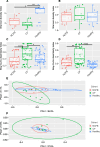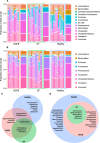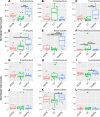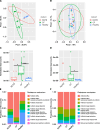Comparative microbiome analysis in cystic fibrosis and non-cystic fibrosis bronchiectasis
- PMID: 38762736
- PMCID: PMC11102160
- DOI: 10.1186/s12931-024-02835-w
Comparative microbiome analysis in cystic fibrosis and non-cystic fibrosis bronchiectasis
Abstract
Background: Bronchiectasis is a condition characterized by abnormal and irreversible bronchial dilation resulting from lung tissue damage and can be categorized into two main groups: cystic fibrosis (CF) and non-CF bronchiectasis (NCFB). Both diseases are marked by recurrent infections, inflammatory exacerbations, and lung damage. Given that infections are the primary drivers of disease progression, characterization of the respiratory microbiome can shed light on compositional alterations and susceptibility to antimicrobial drugs in these cases compared to healthy individuals.
Methods: To assess the microbiota in the two studied diseases, 35 subjects were recruited, comprising 10 NCFB and 13 CF patients and 12 healthy individuals. Nasopharyngeal swabs and induced sputum were collected, and total DNA was extracted. The DNA was then sequenced by the shotgun method and evaluated using the SqueezeMeta pipeline and R.
Results: We observed reduced species diversity in both disease cohorts, along with distinct microbial compositions and profiles of antimicrobial resistance genes, compared to healthy individuals. The nasopharynx exhibited a consistent microbiota composition across all cohorts. Enrichment of members of the Burkholderiaceae family and an increased Firmicutes/Bacteroidetes ratio in the CF cohort emerged as key distinguishing factors compared to NCFB group. Staphylococcus aureus and Prevotella shahii also presented differential abundance in the CF and NCFB cohorts, respectively, in the lower respiratory tract. Considering antimicrobial resistance, a high number of genes related to antibiotic efflux were detected in both disease groups, which correlated with the patient's clinical data.
Conclusions: Bronchiectasis is associated with reduced microbial diversity and a shift in microbial and resistome composition compared to healthy subjects. Despite some similarities, CF and NCFB present significant differences in microbiome composition and antimicrobial resistance profiles, suggesting the need for customized management strategies for each disease.
Keywords: Bronchiectasis; Cystic fibrosis; Microbiome; Non-cystic fibrosis; Resistome.
© 2024. The Author(s).
Conflict of interest statement
The authors declare no competing interests.
Figures







Similar articles
-
[Chinese experts consensus statement: diagnosis and treatment of cystic fibrosis (2023)].Zhonghua Jie He He Hu Xi Za Zhi. 2023 Apr 12;46(4):352-372. doi: 10.3760/cma.j.cn112147-20221214-00971. Zhonghua Jie He He Hu Xi Za Zhi. 2023. PMID: 36990700 Chinese.
-
Comparison of respiratory pathogen colonization and antimicrobial susceptibility in people with cystic fibrosis bronchiectasis versus non-cystic fibrosis bronchiectasis: a protocol for a systematic review.Syst Rev. 2021 Jan 4;10(1):7. doi: 10.1186/s13643-020-01557-6. Syst Rev. 2021. PMID: 33397475 Free PMC article.
-
Three clinically distinct chronic pediatric airway infections share a common core microbiota.Ann Am Thorac Soc. 2014 Sep;11(7):1039-48. doi: 10.1513/AnnalsATS.201312-456OC. Ann Am Thorac Soc. 2014. PMID: 24597615 Free PMC article.
-
Spotlight on inhaled ciprofloxacin and its potential in the treatment of non-cystic fibrosis bronchiectasis.Drug Des Devel Ther. 2018 Nov 27;12:4059-4066. doi: 10.2147/DDDT.S168014. eCollection 2018. Drug Des Devel Ther. 2018. PMID: 30568427 Free PMC article. Review.
-
Inhaled antibiotics in Cystic Fibrosis (CF) and non-CF bronchiectasis.Semin Respir Crit Care Med. 2015 Apr;36(2):267-86. doi: 10.1055/s-0035-1547346. Epub 2015 Mar 31. Semin Respir Crit Care Med. 2015. PMID: 25826593 Review.
Cited by
-
Meta-transcriptomics Reveals Dysbiosis of the Respiratory Microbiome in Older Adults with Long COVID.Research (Wash D C). 2025 Jun 2;8:0720. doi: 10.34133/research.0720. eCollection 2025. Research (Wash D C). 2025. PMID: 40458610 Free PMC article.
-
Pulmonary Delivery of Antibiotics to the Lungs: Current State and Future Prospects.Pharmaceutics. 2025 Jan 15;17(1):111. doi: 10.3390/pharmaceutics17010111. Pharmaceutics. 2025. PMID: 39861758 Free PMC article. Review.
-
Differences in pulmonary microbiota of severe community-acquired pneumonia with different pathogenic microorganisms in children.BMC Pediatr. 2025 Jun 3;25(1):449. doi: 10.1186/s12887-025-05819-x. BMC Pediatr. 2025. PMID: 40462041 Free PMC article.
References
-
- Aliberti S, Goeminne PC, O’Donnell AE, Aksamit TR, Al-Jahdali H, Barker AF, et al. Criteria and definitions for the radiological and clinical diagnosis of bronchiectasis in adults for use in clinical trials: international consensus recommendations. Lancet Respir Med. 2022;10:298–306. doi: 10.1016/S2213-2600(21)00277-0. - DOI - PubMed
Publication types
MeSH terms
Grants and funding
- 21/2551-0000103-8/Fundação de Amparo à Pesquisa do Estado do Rio Grande do Sul
- 21/2551-0000103-8/Fundação de Amparo à Pesquisa do Estado do Rio Grande do Sul
- 21/2551-0000103-8/Fundação de Amparo à Pesquisa do Estado do Rio Grande do Sul
- 21/2551-0000103-8/Fundação de Amparo à Pesquisa do Estado do Rio Grande do Sul
- 21/2551-0000103-8/Fundação de Amparo à Pesquisa do Estado do Rio Grande do Sul
- 21/2551-0000103-8/Fundação de Amparo à Pesquisa do Estado do Rio Grande do Sul
- 21/2551-0000103-8/Fundação de Amparo à Pesquisa do Estado do Rio Grande do Sul
- 21/2551-0000103-8/Fundação de Amparo à Pesquisa do Estado do Rio Grande do Sul
- 21/2551-0000103-8/Fundação de Amparo à Pesquisa do Estado do Rio Grande do Sul
- 2021-0322/Financiamento e Incentivo à Pesquisa - Hospital de Clínicas de Porto Alegre - Fipe/HCPA
- 2021-0322/Financiamento e Incentivo à Pesquisa - Hospital de Clínicas de Porto Alegre - Fipe/HCPA
- 2021-0322/Financiamento e Incentivo à Pesquisa - Hospital de Clínicas de Porto Alegre - Fipe/HCPA
- 2021-0322/Financiamento e Incentivo à Pesquisa - Hospital de Clínicas de Porto Alegre - Fipe/HCPA
- 2021-0322/Financiamento e Incentivo à Pesquisa - Hospital de Clínicas de Porto Alegre - Fipe/HCPA
- 2021-0322/Financiamento e Incentivo à Pesquisa - Hospital de Clínicas de Porto Alegre - Fipe/HCPA
- 2021-0322/Financiamento e Incentivo à Pesquisa - Hospital de Clínicas de Porto Alegre - Fipe/HCPA
- 2021-0322/Financiamento e Incentivo à Pesquisa - Hospital de Clínicas de Porto Alegre - Fipe/HCPA
- 2021-0322/Financiamento e Incentivo à Pesquisa - Hospital de Clínicas de Porto Alegre - Fipe/HCPA
- 2021-0322/Financiamento e Incentivo à Pesquisa - Hospital de Clínicas de Porto Alegre - Fipe/HCPA
LinkOut - more resources
Full Text Sources
Medical

